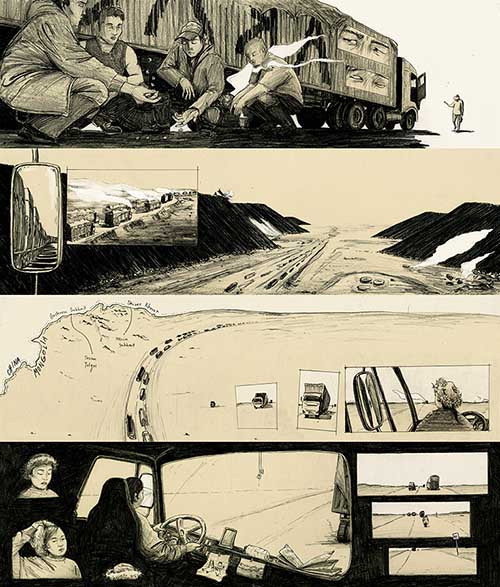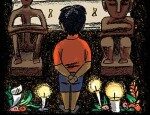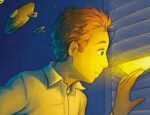10 YEARS OF THE BF SIX TO WATCH! Since we announced Mereida Fajardo as one of our Broken Frontier ‘Six to Watch’ creators back in 2021 the Bristol-based comics artist has gained widespread acclaim for her experimental approach to comics, particularly in terms of their physicality and how she uses those tactile qualities to enhance the thematic properties of her work. This was recognised at the end of last year when her graphic-novel-in-progress Zayani Zam was shortlisted for the prestigious First Graphic Novel Competition.
Today at BF we catch up with Fajardo to talk about interrogating the possibilities of the form, life as a recent graduate, and her work as a co-organiser of zine and illustration fair Zinezilla which returns this Sunday, March 10th for its third annual outing…

Mereida Fajardo at the South London Comic and Zine Fair 2022
ANDY OLIVER: When last we spoke on the site back in 2021 you said you wanted to use the medium to tell stories that could only exist as comics. Since then you’ve become renowned for tactile, experimental work that could never be replicated digitally. Can you tell us a little about comics like Throwing Pennies, Naglalamay, Limpet Love and The Painted Nuns of Santa Catalina and how you used the physicality of the form to reflect the subject matter and themes of those publications?
MEREIDA FAJARDO: In each of these projects, the story evolved simultaneously with the format – they don’t exist without each other, and I struggle to know how the story takes shape without knowing what the format is gonna be and how readers might approach it.
I like when there is some ambiguity and surprise to the reading experience – Throwing Pennies (below) is pretty abstract, the mini zines can be read in any order with each adding to the tapestry of the scene. The idea of the different viewpoints to explore the story (a boy diving for pennies) and themes such as imbalances in wealth developed with my desire to manipulate a piece of paper in different ways. I like how different people may have varying experiences of the story depending on where they start and how they unfold each zine.

Naglalamay (below) is a more linear story, so here the folding pattern allows me to expand and contract page size for impact; the spirit scene and the afterlife vista take up much more space and ripple over creases while the real-life scenes are restricted within their pages. And with the longer concertina-ed pages, when the page turn does come, it carries more weight, like the transition from real world to afterlife.

The Nuns have proven the most confusing to read, as the pages unfold into a cross and the order you read the pages in is unclear. It’s perhaps more of a failed experiment, despite my cheeky attempt to add page numbers. But experimenting with the form also allows me to draw on different objects and artifacts – here the reference point was medieval traveling altarpieces that unfolded into vast displays. These were painted across wooden panels not unlike comic panels, and I liked the idea of bringing this archaic style of comics into a more modern meaning of the word.
AO: You also gained more recognition last year when you were shortlisted for the First Graphic Novel Competition for your work-in-progress Zayani Zam (below). What is the premise of the project and how much of a boost was that to you as an artist?
FAJARDO: It was a huge honour! Big love to the FGN and SelfMadeHero teams for their hard work. It’s invigorating to see so many people being interested in comics and wanting to create opportunities for new stories and creators, when it’s still easy to feel a little adrift and unmoored while self-publishing. And the confidence boost from people saying they liked my work is worth everything!
The story is about loneliness and connection on the Mongolian coal road and follows a day in the life of a female trucker driving coal across the Gobi Desert to the Chinese border. It was inspired by an incredible Guardian documentary called Lady of the Gobi that I’d highly recommend watching, which introduced me to a completely new setting and culture, but I also found elements to relate to in the monotony, the daily grind, the isolation. I wanted to highlight those universal emotions while exploring the specificities of the place and its people.
AO: When our last interview took place you were still a student at university studying for your BA. What else have you been involved with in the comics and illustration world post-graduation and how have you found the comics landscape in that time as a new graduate?
FAJARDO: I’ve been incredibly lucky to work on an illustration residency at Chelsea and Westminster Hospital, using drawing to spotlight the work of hidden departments and teams throughout the hospital. The project was rooted in reportage illustration (below) but I wanted to bring some comicsy stuff (the technical term) into the publication. I avoid drawing in front of people like the plague so it was a little terrifying, and I found it difficult balancing how I usually work (defined story, second-hand research, reference photos, lots of time) with the demands of being on-site. But everyone was so lovely and my confidence grew massively.
Though I wish I’d drawn more comics within the project, it’s awoken an interest in exploring non-fiction, observational comics and graphic journalism. I really feel there is a place for drawing and for visual storytelling in documentary and journalism, as it presents a different way of looking at the world compared to words, or photo or video. I’m just crossing my fingers that there are lots of people out there commissioning and publishing such work!
While I’ve been bringing comics storytelling into other projects, it has been a struggle to find time and energy to make new comics for myself, balancing being an ‘artist’ with being a beer wench and also a functional adult. I’ve attended some really great comic fairs though which always boost my enthusiasm, and sharing a studio with friends in the same position who still find time for personal projects certainly gives me hope 🙂
AO: Your emergence in indie comics has come at a time of great upheaval in the scene in terms of how work is delivered and the platforms/events for promoting it. What have been your main takeaways since your early self-published work and WIP Comics contributions about the way in which the scene has been evolving and adapted in that time?
FAJARDO: I’m no great scholar on the matter and would direct anyone interested towards the work being done by the Comics Cultural Impact Collective, who are gathering important resources and statistics about the scene to fight for better opportunities for comics creators.
I will say that seeing fewer and fewer big publishing houses publish long-form comics is disappointing. Though it makes indie and self-publishing even more vital! There is a readership out there and I really think events are the way forward – I discovered indie comics through chancing upon Catford Comic and Zine Fair and still find it exhilarating to go to fairs and be surrounded by artists allowed space to express themselves fully.

AO: You’ve been organising the Bristol-based Zinezilla fair which returns for its third instalment in March. What can we expect from Zinezilla this time in terms of curation and approach?
FAJARDO: Lots of cool art and a fun day out!! It’s Mother’s Day, so why not bring yer mam. Also sharks. Lots of sharks.
With a smaller venue, we wanted to make sure we have a good spread of artists across various styles and approaches, and ensure each exhibitor gets the attention they deserve and has a good day of it. And it’s an extremely cool lineup, I’m so excited about everyone tabling! We tried to give opportunities to new exhibitors who haven’t tabled with us before, so there should be something for returning visitors to sink their teeth into. We had an absolutely overwhelming number of applications so figuring out the line-up was incredibly difficult and painful. But huge thank you to everyone who applied, it’s a joy to see so many wonderful artists from all over the country who want to take part and it goes to show we need more events like this!
My co-organiser Marcy and I are in our third year of doing it and we get a bit more organised every year, so hopefully the day shall run as smooth as Jason Statham’s head.
AO: As a welcome newer event on the calendar what have been some of the challenges you’ve faced in organising a fair. What have you learnt from the first two Zinezillas?
The challenge hasn’t been finding artists to take part or an audience for them, it’s been facilitating connecting them. We had a fantastically large and free venue for the first two fairs, though venue hire rates have meant we’ve needed to look further afield. Finding funding for an event like this is crucial to tackling that challenge – this is something we’ve been unlucky with thus far and something the scene could really benefit from. The appetite for smaller events is certainly there, not just in Bristol but all over, however the lack of infrastructure and funding available can make it difficult and disheartening.
Luckily, we’ll be hosted by a gorgeous new venue called KIT FORM who have been putting on some great events and exhibitions in the last few months. Thanks team!
I would say the biggest thing Marcy and I have learnt is that we want to have fun while doing this, otherwise we would never do it again. Having mascots, making the promo bright and funky, not taking ourselves too seriously and just being energetic with it, having silly themes (like SHARKS), all of it makes me want to get up in the morning to work on it and filters into the event itself.
A Zinezilla: Megalazine anthology teaser
AO: What has been some of the most rewarding feedback you’ve had about Zinezilla to date?
FAJARDO: New friendships forming, old friends reconnecting, exhibitors having fun and making boatloads of money, kids loving the big dinosaur, people just having a good time!
Marcy highlighted how people have told us that it inspired them to revisit their art after becoming disheartened with it – how Zinezilla giving people new opportunities and bringing artists together made them want to get back into it! We love hearing people saying they never would’ve done something if it weren’t for the event. One of the reasons we started it in the first place was to give new and first-time artists an opportunity, including ourselves, so it’s really cool that we can do that for other people.
AO: This time around you have a Zinezilla anthology as well (reviewed here at Broken Frontier this week). What kind of work can we see in that and who are some of the names involved?
FAJARDO: Agh I am sooooo excited for the anthology! Really, it’s an excuse for Marcy and me to ask a bunch of cool artists to draw us some sharks…
And not just sharks! There’s monsters, megalomaniacs, meditations on loss and ecology, our mascots and even Jason Statham. Everybody had free rein with their submissions so it’s a gorgeous spread of styles and stories, both comics and illustration, and it’ll only put you back £6. All the money from the zine goes right back into making Zinezilla even better.
We’ve got the old guard represented in WJC and Paul Ashley Brown, some up-and-coming artists in comics self-publishing such as Leo Ioviero and Roman Macrae, alongside exciting new names who haven’t published much work before. Come take a dive with us! We promise you a good time 🙂

Some of Mereida’s own work from the anthology
AO: And finally what else can we expect from you in 2024? What other projects are you working on?
FAJARDO: Alongside some cool upcoming commissioned work I’m hoping to get back to making my own zines – working on a cerebral exploration of memorials, and a medieval sex comedy. Although first things first, I’m going to sleep like an absolute rock after Zinezilla. And not work on anything for a bit. And drink a lot of beer.
Buy the Zinezilla: Megalazine online here
For more about Zinezilla check out the Instagram account here
Visit Mereida Fajardo’s online store here
2024 marks the tenth year of Broken Frontier’s ‘Six to Watch‘ initiative. Look for articles throughout the year celebrating the work of those artists who have been a part of the programme.





















[…] a recent interview with comics web magazine “Broken Frontier,” Fajardo admits the project felt terrifying at first (“I usually avoid drawing in front of […]
[…] a recent interview with comics web magazine “Broken Frontier,” Fajardo admits the project felt terrifying at first (“I usually avoid drawing in front of […]